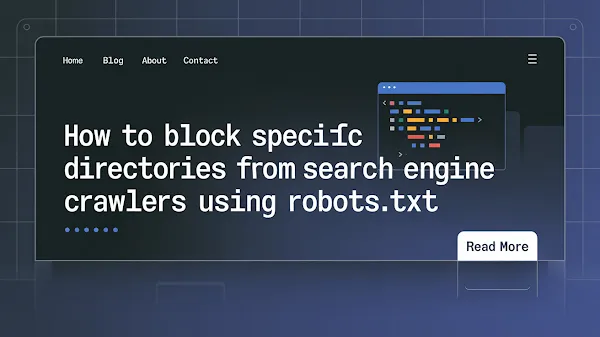How to Block Specific Directories from Search Engine Crawlers Using Robots.txt
Search engine crawlers systematically scan websites to index content for search results. However, certain directories on your website—such as admin panels, temporary files, or development folders—may contain sensitive or irrelevant content that shouldn't appear in search results. The robots.txt file provides a straightforward way to control crawler access. This guide explains how to use this file to block specific directories effectively.
Understanding the Robots.txt File
The robots.txt file is a text-based protocol that instructs web crawlers which parts of your site they can or cannot access. It resides in the root directory of your website (e.g., https://www.example.com/robots.txt). Crawlers read this file before scanning your site, ensuring compliance with your rules.
Basic Structure of Robots.txt
User-agent: [crawler-name]
Disallow: [directory-path]Step-by-Step Guide to Block Directories
1. Identify Directories to Block
Determine which directories you want to exclude from search engine indexing. Examples include:
/admin//tmp//private/
2. Create or Edit the Robots.txt File
Create a plain text file named robots.txt and place it in your website's root directory. Use the following syntax to block directories:
User-agent: *
Disallow: /admin/
Disallow: /tmp/
Disallow: /private/The User-agent: * applies the rules to all crawlers. Each Disallow line specifies a directory to block.
3. Target Specific Crawlers (Optional)
To block directories for specific crawlers, replace * with the crawler's name. For example:
User-agent: Googlebot
Disallow: /private/4. Allow Access to Non-Blocked Content
If you want to block most directories but allow a few, use the Allow directive:
User-agent: *
Disallow: /private/
Allow: /public/Common Mistakes to Avoid
- Case Sensitivity: Directory paths are case-sensitive.
Disallow: /Admin/won’t block/admin/. - Trailing Slashes: Use
/directory/to block an entire directory. Omitting the slash may block unintended paths. - Wildcard Misuse: Avoid using
*in paths unless necessary (e.g.,Disallow: /*.php$to block PHP files).
Testing Your Robots.txt File
After updating robots.txt, validate it using tools like Google Search Console’s Robots Testing Tool. This ensures crawlers interpret your rules correctly.
Important Notes
- Security Warning:
robots.txtis publicly accessible. Do not use it to hide sensitive data—use authentication ornoindextags instead. - Crawler Compliance: Rules are voluntary. Malicious crawlers may ignore them.
Conclusion
Using robots.txt to block directories is a simple yet powerful method to control search engine indexing. By following the steps above, you can ensure crawlers only access content you want to appear in search results. Regularly audit your robots.txt file to maintain accuracy and security.

Join the conversation